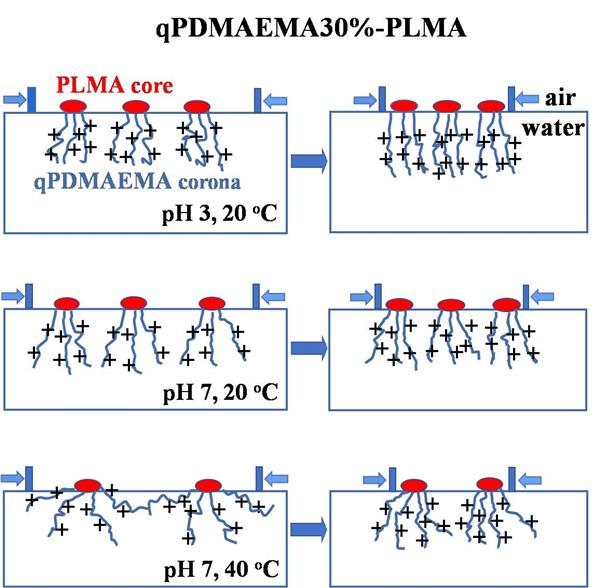24.【J. Appl. Polym. Sci.】Aggregation behavior of the strong amphiphilic cationic diblock polyelectrolytes at the air/water interface
writer:Y. Ding, G. Wen*, V. Chrysostomou, S. Pispas, K. Jiang, Z. Sun, H. Li
keywords:Langmuir-Blodgett film; Block copolymer; qPDMAEMA-b-PLMA; Subphase pH
source:期刊
specific source:J. Appl. Polym. Sci. 2022, 139(18), e52079.
Issue time:2021年
Effects of subphase temperature and pH on the interfacial behavior of two strong amphiphilic cationic diblock polyelectrolytes, quaternized poly(2-(dimethylamino)ethyl methacrylate)-block-poly(lauryl methacrylate) (qPDMAEMA-b-PLMA), were studied by the Langmuir film balance technique for the first time. The morphologies of their Langmuir-Blodgett (LB) films were studied by atomic force microscopy. At the air/water interface, surface micelles with hydrophobic PLMA cores and hydrophilic qPDMAEMA coronas form. With the increase of temperature, the condensed surface pressure-molecular area isotherms move to large area (right shift). The higher the temperature, the more obvious the isotherm shifts to the right. At low temperature, the isotherms of the two copolymers are almost respectively overlapped under different subphase pH conditions. At high temperature, however, the isotherms of the two copolymers show some subphase pH dependence. All initial LB films obtained at different subphase conditions exhibit isolated circular micelles. Under different subphase pH conditions, the diameters of the micelle cores in the two copolymers’ LB films obtained at low temperature are close but larger than those at high temperature, which phenomenon is first reported. This is probably due to the relatively lower mobility of polymer individual chains at low temperature, resulting in their higher local surface concentration and larger aggregation.

Artical address: https://doi.org/10.1002/app.52079.